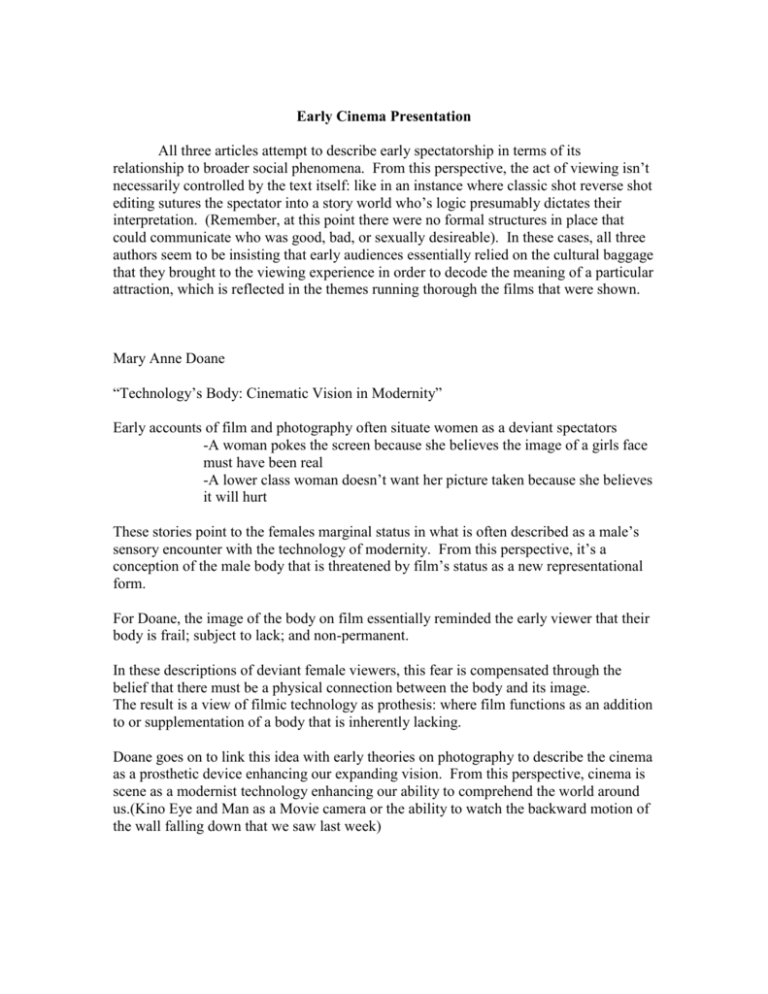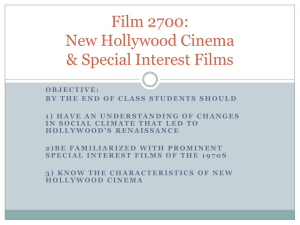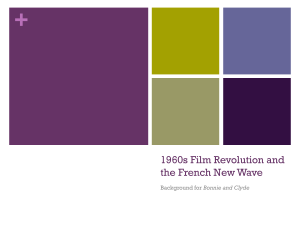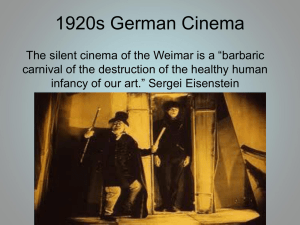
Early Cinema Presentation
All three articles attempt to describe early spectatorship in terms of its
relationship to broader social phenomena. From this perspective, the act of viewing isn’t
necessarily controlled by the text itself: like in an instance where classic shot reverse shot
editing sutures the spectator into a story world who’s logic presumably dictates their
interpretation. (Remember, at this point there were no formal structures in place that
could communicate who was good, bad, or sexually desireable). In these cases, all three
authors seem to be insisting that early audiences essentially relied on the cultural baggage
that they brought to the viewing experience in order to decode the meaning of a particular
attraction, which is reflected in the themes running thorough the films that were shown.
Mary Anne Doane
“Technology’s Body: Cinematic Vision in Modernity”
Early accounts of film and photography often situate women as a deviant spectators
-A woman pokes the screen because she believes the image of a girls face
must have been real
-A lower class woman doesn’t want her picture taken because she believes
it will hurt
These stories point to the females marginal status in what is often described as a male’s
sensory encounter with the technology of modernity. From this perspective, it’s a
conception of the male body that is threatened by film’s status as a new representational
form.
For Doane, the image of the body on film essentially reminded the early viewer that their
body is frail; subject to lack; and non-permanent.
In these descriptions of deviant female viewers, this fear is compensated through the
belief that there must be a physical connection between the body and its image.
The result is a view of filmic technology as prothesis: where film functions as an addition
to or supplementation of a body that is inherently lacking.
Doane goes on to link this idea with early theories on photography to describe the cinema
as a prosthetic device enhancing our expanding vision. From this perspective, cinema is
scene as a modernist technology enhancing our ability to comprehend the world around
us.(Kino Eye and Man as a Movie camera or the ability to watch the backward motion of
the wall falling down that we saw last week)
However, alongside this conception that film turns people into cyborgs runs the need to
assure viewers that their spectoral bodies are safe, and that were not being dehumanized
by the machine.
Interstingly enough these dilemas turned into narratives; Like Uncle John at the moving
picture show, which we saw last week, where a man tries to interact with the images
projected onto a screen. This also recalls Gunning’s description of early cineam as a kind
of roller coaster ride, where your shoked by the images while still being reminded of the
saftety of spectoral distance.
For Doan, the tension between shock and the need to reinforce the spectators safety is
evident in some very sadistic early silent films that dealt with violence and death. From
this perspective, death on screen reminds the audience these acts aren’t happening to
them or they’d be dead (Abject Violence).
The result was a prevalence of execution films that blurred the line between fiction and
documentary: Edisons Electrocution of an Elephant or Execution by hanging, or
Beheading the Chinese Prisoner. From a technological perspective, the element of
execution was important because they were timed public events that could be captured.
These instances, as well as examples like the prevalence of pain inflicted on the body in
comedies, and Melie’s empasis on disappearing bodies, suggest that issues of
representation in early were predominantly focused around the human body. From this
perspective, this is a body that is continually put at risk, and often assaulted by the
shock of modernity.
The Cinema’s constant return to the body is symptomatic of a troubled confrontation with
the dehumanization of machine.
The result is a contradictory desire to humanize the machine, but still appeal to it as a
supplement of the human body to make up for its lack.
For Doan, THE BODY AT ISSUE IN THESE DISCOURSES IS SEXUALLY AND
RACIALLY UNSPECIFIED, SUGGESTING THAT ONE IS ALWAYS DEALING
WITH THE WHITE MALE BODY. IT IS THE MALE BODY THAT IS PUT AT
RISK BY MODERNITY.
This can be placed in context with a lot of the speculation in the late 19th and early 20th
century where the effects of massive techniological change lead to a reading where the
body is seen as a machine.
For Doan, a way of dealing with this is to construct a discourse that constututes itself as a
denial of the body through the projection of contingency and embodiment onto the white
woman and the racial other.The cinema accomplishes this through the progessive
disembodiment of the spectorial position resulting in a situation where the spectator
becomes detatched and dissassocited from the space of perception.
THIS POSITION IS CONDUSIVE TO THE RECEPTION OF A TECHNICALLY
SUPPORTED SPECTACLE – A SPECTACLE WHO’S PRINCIPLE CONTENT IS
FEMALE EMBODIMENT
In other words white men didn’t want to see themselves on screen because it made them
feel anexiety, so they’d prefer to see images of an other that could be objectified. From
this perspective, the “attraction” was the spectacle of a woman or racial other, which
was the case in the beheading of a chinese prisoner.
As a result, the female body becomes a spectacle which also serves as a demonstration of
the males technological prowess. So we essentially get a the creation of a gendered space
where the white male is behind the camera recording the female attraction.
Scenarios of Exposure in the Practice of Everyday Life: Women in the Cinema of
Attractions.
Constance Balides
Many early shorts involve the sexual objectification of white working class women;
primarily through wardrobe malfunctions. These differ from films showing the bodies of
strong men because they are mini-narratives organized around the revealing of a female
body part. Interestingly enough, a lot of these films are set during everyday situations
which is designed to give the impression that they weren’t staged. (recall the way the
concept of actuality blurs lines between fiction and non-fiction)
Films of this nature depict women dong laundry, walking over hot air vents, working
out, getting fitted for dresses, and essentially involve comic gags resulting in situations
where covered aspects of the female body become revealed. From this perspective, these
films are structured around the incidence of display.
In the cinema of attractions, women function as an attraction for the viewer who is often
situated as a white male. Often in the endings of such films men are chastisised for
looking and there is often humor derived from this. In many cases this humor revolves
around violence, like a woman beating a man over the head with an umbrella.
In this process there is no shot reverse shot continutiy editing in order to control the
spectators gaze, but Constance Balides insists that the use of everyday sitatuations works
to orient practices of looking. From this perspective, these films rely on broader social
relations (namely the history of female sexual objectification) existing outside of the text
in order to influence viewership.
One of the film’s mentioned is called What Demoralized the Barber Shop in which men
are whipped into a frenzy while gazing at the sight of female legs. In this example, the
notion of the barbershop being a real gendered place where men sit together and oggle
the women passing by can be seen as a broader social relation influencing spectatorship.
These films often stress accidental circumstances in which a portion of the female body is
revealed and often occur in work settings that require a close proximity between males
and females. This stategy reinforces the eroticism by alluding to the idea that the camera
spontaneously caught the moment; however, as we know know, due to the technical
contraints of early film technology such events were clearly staged.
From this perspective, these films produce the everyday space as something other.
Public spaces basically becomes a sexualized place where women are nothing more than
a spectacle. This process results on the creation of a masculine voyeruistic place that
peers into a feminine space.
This practcve can be seen as the result of the increased public visibility of women
occuring in the late 19th and early 20th century; primarily referring to the increased
presence of females in the workplace (ie. Department stores) and the fact that many
women were beginning to live on their own. From this perspective, these films can be
seen as the result of negative attitudes surrounding the shifting of gendered boudaries,
which is predominantly read through endings where male voyeurs are punished.
This reading can also be seen as an symptom of an increased blurring between everyday
public spaces and sexual spaces brought on by modernism.
The Lady Vanishes: Women, Magic, and the Movies
Lucy Fischer
Fisher essentially sees early gender portrayals of men and women in magical film as
having stemmed from gender relations that were already situated in theatrical magic.
Melie’s early magical shorts often represented the act of making his female assistants
dissapear.Many of Melie’s later films elaborated on the same situation by performing
other astouding feets on female subjects, such as levitation. From this persepctive,
Melie’s can be seen as the inadvertant patriarch of the early cinematic vision of women.
This vision stems from gender relations in theatrical magic where the magician was
predominantly male with a female subject.
For Fischer, the act of making females dissapear and reappear can be seen as the
reflection of a man’s power over women. The conjured woman also acts as a decorated
object of display while taking on the form of a spiritual or mysteious other, which is
reflected in several films by Melie which deal with men dreaming of female visions.
For Fischer, it can be tempting to read these acts as a symbol of the man’s power over
women, but the need to repeatedly control the female form through the use of magic also
speaks of a male’s percieved weakness in relation to women; for if a magician is
competant with his power over woman why must he keep demonstrating his ability to
manipulate them? From this perspective, magic demonstrates masculine power while
simultaneously revealing anexieties concerning a female’s power over males.
Interestingly enough, there are films where female magicians have power over men. Like
Edison’s Pipe Dream made in 1905. In almost all of these cases, women who have
magical powers are seen as being evil and dangerous to men. We only need to think of
the history of filmic representations of the witch to find a suitable cultural reference
point.
Here we get a reversal of the male magician/female subject paradigm where females are
no longer passive props but a representation of a dangerous carnality.
According to Fischer, this fear of female sexuality can be seen in the rampant hostility
towards female subjects that often occur in early theatrical and cinematic magic.
-Melie’s turing a women into a skeleton or turning a bunch of manequin limbs into a real
woman.
-Even tricks such as men pulling rabbits out of hats represent an act of creation that
mimic a female’s ability to give birth.
Since film is often seen as a kind of magical medium, it would make sense to assume that
the gendered relations of early magic acts were easily transposed to early cinema.
Questions?
In what way does the “cinema of attractions function today”? Where do we see
spectacular images of comic violence, death, and sex presented in a non-narrative format
and what role has changes in technology played in this?
Do these gendered binaries of viewership still hold weight, if you agree that they did in
the first place? Is the spectator in the modern cinema of attractions predominanlty white
male?








